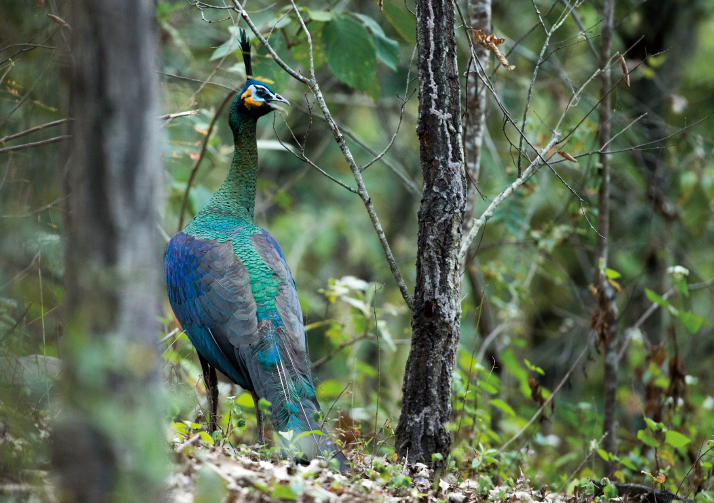| China |
| A Victory for Nature | |
| Court ruling in favor of wildlife habitat has far-reaching implications | |
|
|
 A green peacock strolls in a forest in Yunnan Province, southwest China, in 2017 (XI ZHINONG)
Crisscrossed with mountains and rivers, Chuxiong Yi Autonomous Prefecture in the southwestern province of Yunnan is a sanctuary for abundant wildlife, including rare plants such as the cycad and animals such as green peafowls and geckos. The area is also rich in hydropower resources. Over the past few decades, several hydropower stations have been built there. However, the recent construction of a power station on the Jiasa River, the upper reaches of the Honghe River (Red River) that flows to Viet Nam, has pitched hydropower development against wildlife conservation because the damming of the river for electricity generation will submerge a habitat of the green peafowl, an endangered species. On March 20, the Kunming Intermediate People's Court in Yunnan made a first-instance ruling on a public-interest litigation (PIL) regarding the hydropower project. The court ordered an immediate suspension of its construction. The court order sent a clear message, heralding a new beginning for PIL involving wildlife protection, Qian Yefang, a professor at the School of Law and Politics of Zhejiang Sci-Tech University, told Beijing-based China Environmental News.  Members of Friends of Nature, a non-governmental organization, during a field investigation along the Honghe River in Yunnan on March 9, 2018 (COURTESY PHOTO)
Under threat The case has been hailed as the first preventive PIL concerning wildlife protection. It is preventive in the sense that serious harm has not yet occurred. "The damage to the habitat will be irreversible, and the value of an endangered species is immeasurable," Ge Feng, an environmental policy advisor of Beijing-based non-governmental organization (NGO) Friends of Nature, told Beijing Review. The organization was the plaintiff in the case. The green peafowl, formally known as Pavo muticus, is one of the most threatened animals in the world. There are mainly two types of peafowls, green and blue. While the former is endangered, the latter is widely kept in zoos and raised on animal farms. In 2009, the conservation status of the green peafowl on the International Union for Conservation of Nature (IUCN) Red List was elevated from vulnerable to endangered, indicating that it has become even rarer. In 2017, Yunnan listed the bird as critically endangered. The Chinese Government has put it under top-level protection. Based on a years-long survey, Kong Dejun, a faculty member at Kunming University in Yunnan, told Xinhua News Agency in 2018 that there were no more than 500 green peafowls living in the wild in China. According to an assessment by the IUCN in 2018, the worldwide population of mature peafowls was between 10,000 and 19,999. "The peafowls usually seen in zoos are the blue ones or the hybrids of green and blue ones," said Yang Xiaojun, a researcher with the Kunming Institute of Zoology. Green and blue peafowls originated from different regions. The former is native to tropical and subtropical forests in Southeast Asia and south China, whereas the latter comes from South Asian countries such as India and Sri Lanka. They also differ in physical traits. A major distinction is that the crown of a green peafowl features feathers tightly clustered together, whereas that of its blue counterpart spreads out like an unfolded fan. The green peafowl has green and golden scale-shaped feathers on its neck and chest, and the blue one blue and filamentous feathers. Their face colors, calls and some living habits also differ. According to the IUCN, in China, green peafowls were previously reported in Zhejiang, Hubei and Sichuan provinces as well as Guangxi Zhuang Autonomous Region, but gradually disappeared from these regions in the 20th century. Now, they are known to be found almost exclusively in Yunnan, mainly limited to the tropical forest areas on the banks of the middle and lower reaches of the Lancang, Nujiang and Honghe rivers. A main factor leading to the drastic decline is habitat change and destruction, Yang said. Green peafowls mainly inhabit tropical and subtropical evergreen forests up to 2,000meters above the sea level, especially along river banks or in open areas, where human activities have increased, he added. The middle and upper reaches of the Honghe are a major habitat of green peafowls. In the lawsuit, Friends of Nature presented evidence to the court that the planned reservoir of the hydropower station would inundate the green peafowl habitat. The court ordered immediate suspension of the construction. It also ruled that competent authorities will decide what to do next with the project after the builder takes an ex-post environmental impact assessment in accordance with the requirements of the Ministry of Ecology and Environment (MEE) and submits improvement measures. For Friends of Nature, the suspension of the project is not enough. To halt it permanently, it, together with three other environmental NGOs, submitted a petition to MEE on March 25, requesting it to revoke its approval of environmental impact assessment report (EIA) for the hydropower project, so that the green peafowls' habitat can be preserved. The NGOs argued that the project's environmental impact assessment was seriously flawed for it was not based on careful field research of the green peafowls' habitat. In addition, it did not evaluate the project's impact on the cycas chenii, a cycad variety that was first discovered in China in 2015, after the project's preliminary environmental assessment was made. A legal weapon The EIA for the hydropower project with a total investment exceeding $500 million was approved by MEE in 2014, and the construction of the dam started in 2016. In March 2017, green peafowls were photographed in the river valleys which would be flooded by the dam. In the same month, Friends of Nature, together with two other environmental NGOs, submitted an urgent request to the Ministry of Environmental Protection (the predecessor of MEE), calling for suspension of the dam construction. In July 2017, Friends of Nature filed a public-interest lawsuit with the Chuxiong Intermediate People's Court against Kunming Engineering, the general contractor of the project, and Xinping Development under China Hydropower Engineering Consulting Group Corp. that has undertaken the construction work. The case was transferred to the Kunming Intermediate People's Court one month later. Meanwhile, under public pressure, the dam builder suspended the construction, and has not restarted it so far. The defendants argued that the habitat of green peafowls lies in the Konglong River Nature Reserve and not in the would-be submerged areas. The nature reserve was set up by the government in 2003 mainly to protect the habitat and Hume's pheasant, a bird with black neck and long tail. Friends of Nature said the area of the nature reserve had been reduced three times for hydropower development. From 2017 to 2019, zoological experts and environmental activists conducted a number of field investigations in the area, and gathered strong evidence proving green peafowls' presence in the would-be submerged area, according to Friends of Nature. With the evidence, Friends of Nature won the first-instance case, which is also a victory for PIL. Since 2012, PIL has been used in China as a legal weapon for environmental protection, with the amendment of the Civil Procedure Law that year. Article 55 of the new law states that government organs and relevant organizations prescribed by law may bring a lawsuit in the people's court for acts that hurt public interests, such as environmental pollution and infringement of the legitimate rights and interests of consumers. Before 2012, only direct victims of environment-related crimes were qualified to sue the perpetrators. Environmental PILs began to grow after the amended Environmental Protection Law went into force in January 2015, which clarifies the types of social organizations eligible to file such cases, wrote Jiang Bixin, Vice President of the Supreme People's Court (SPC), China's highest judicial authority, in an article in Journal of Law Application. In July 2015, authorized by the National People's Congress, China's top legislature, 13 provincial-level administrative regions began to pilot the filing of PILs by procuratorial organs. In June 2017, the Civil Procedure Law and the Administrative Procedure Law were amended, authorizing procuratorial organs to file PILs. According to the SPC, Chinese courts heard more than 5,000 environmental PIL cases from January 2015 to December 2019. Despite the progress, environmental PILs still face challenges. A difficulty in filing such lawsuits is that environmental damage is huge and hard to assess, according to Jiang. He said currently a majority of such lawsuits are filed by procuratorial organs rather than social organizations. Copyedited by Madhusudan Chaubey Comments to wanghairong@bjreview.com |
|
||||||||||||||||||||||||||||
|